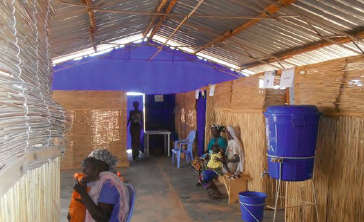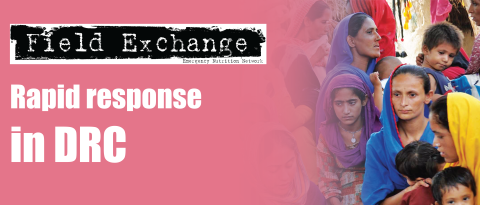Inflammation and moderate acute malnutrition in children: A cross-sectional study in Burkina Faso
Summary of conference abstract1
Presented at the ACF research conference, November 9, 2016. Published research: B Cichon, F Fabiansen, CW Yaméogo, MJH Rytter, C Ritz, A Briend, VB Christensen, KF Michaelsen, R Oummani, S Filteau, P Ashorn, S Sheperd and H Friis. Children with moderate acute malnutrition have inflammation not explained by maternal reports of illness and clinical symptoms: a cross-sectional study in Burkina Faso. BMC Nutr. 2016;2:10.1186/s40795-016-0096-0.
By Bernardette Cichon
Bernardette Cichon is undertaking her PhD at the University of Copenhagen. She has an MSc in Public Health Nutrition from the London School of Hygiene and Tropical Medicine and more than eight years experience working with nutrition in humanitarian contexts.
The treatFOOD project is a collaboration between ALIMA, MSF-Denmark and the University of . It was funded by DANIDA, MSF-Denmark, MSF-Norway, WFP, USAID, ECHO and Arvid Nilsson’s Foundation. See www.treatfood.org
Video footage of the conference presentation is available here.
Location: Burkina Faso
What we know: The role of morbidity in moderate acute malnutrition (MAM) is not well understood.
What this article adds: An observational study in Burkina Faso, using baseline data from a randomised controlled trial, described morbidity and inflammation in children with MAM. Almost 90% of children with MAM in this setting had an infection and/or inflammation. Maternal history reported a 38% infection rate in the previous two weeks; 71.8% were ill on the day of visit. Most prevalent diagnosed illnesses were malaria (40.2%), lower respiratory tract infections (23.2%), and upper respiratory tract infections (14.6%); fever was common. A total of 10.7% and 46.5% of asymptomatic children had elevated acute phase proteins (CRP and AGP, respectively), suggesting sub-clinical infection. This was largely unexplained by maternal reports and clinical examination. More emphasis on identification and treatment of infections as part of MAM treatment and investigation into how this affects nutritional status and recovery is needed.
Background
 Morbidity plays an important role in the development of and recovery from malnutrition. Morbidity in children with moderate acute malnutrition (MAM) has not been described in detail and it is unclear how morbidity compares to serum levels of acute phase proteins (APPs) which indicate systemic inflammation that can impede response to therapeutic nutritional interventions. The objective of this study was to describe morbidity and inflammation in children with MAM and to assess to what extent maternally reported and clinically diagnosed morbidity explains the variation in APPs.
Morbidity plays an important role in the development of and recovery from malnutrition. Morbidity in children with moderate acute malnutrition (MAM) has not been described in detail and it is unclear how morbidity compares to serum levels of acute phase proteins (APPs) which indicate systemic inflammation that can impede response to therapeutic nutritional interventions. The objective of this study was to describe morbidity and inflammation in children with MAM and to assess to what extent maternally reported and clinically diagnosed morbidity explains the variation in APPs.
Methods
The data for this observational study were baseline data collected as part the treatFOOD trial, a randomised controlled trial testing effectiveness of food supplements for treatment of MAM, carried out in the Passoré Province, Northern Region, Burkina Faso. Children aged 6-23 months with MAM, resident in the catchment area and whose parents/guardians consented to participate, were included. Recruitment took place from September 2013 until August 2014.
Socio-demographic, anthropometric and morbidity data were collected by trained staff. Morbidity data collection included a patient history based on 14-day maternal recall of symptoms and a physical examination carried out by study nurses. Venous blood (2.5 ml) collected from the arm was used for diagnosis of malaria, using a rapid diagnostic test (RDT), and to measure serum concentrations of C-reactive protein (CRP) and α1-acid glycoprotein (AGP). Fever was defined as an axillary temperature > 37.5 °C. Upper and lower respiratory tract infections were diagnosed by experienced nurses based on an adapted version of the Integrated Management of Childhood Illnesses (IMCI) guidelines. Diarrhoea was defined as three or more loose, watery stools per day based on information provided by the mother. The thresholds used for defining elevated APP levels were CRP >10mg/l and AGP >1g/l. Multivariate ANCOVA models were used to explore the associations between morbidity and CRP as well as AGP. These models were also used to determine to what extent morbidity explains variation in APPs.
Results
A total of 1,609 children were enrolled in the study. Over half (54.6%) of participants were female. Prevalence of stunting (height-for-age <-2 z score) was 37.7%. The mean (SD) age was 12.3 (4.8) months.
Mothers reported illnesses in the two-week period prior to admission in 38% of children. Furthermore, 71.8% of children were ill on the day of the visit according to the physical examination by the study nurse. The most prevalent illnesses diagnosed by the nurse were malaria based on positive RDT (40.2%), lower respiratory tract infections (23.2%) and upper respiratory tract infections (14.6%). Fever was also common (17.7%). Almost a quarter (24.2%) and two thirds (66.4%) of children had serum CRP >10 mg/l and serum AGP >1 g/l, respectively.
Positive malaria RDTs were more common among children admitted based on mid-upper-arm circumference (MUAC) only than children admitted based on weight-for-height z score (WHZ) only, after adjustment for age and sex (38% vs 26%, p<0.001). More children had lower respiratory tract infection if they were admitted based on WHZ only compared to MUAC only, after adjustment for age and sex (29% vs 21%, p=0.006). There were no associations between other symptoms, illnesses and APP levels and admission categories. A total of 10.7% (n=36) and 46.5% (n=157) of asymptomatic children had a CRP >10 mg/l and AGP >1 g/l, respectively. Only 19% of children had normal CRP and 12% had normal AGP in the absence of symptoms.
History of fever as well as nurse-documented fever, malaria, respiratory tract infections and skin infections were associated with higher levels of both APPs. History of cough and diarrhoea at the inclusion visit was associated with higher AGP only. Overall, morbidity data only explained a small amount of the variation in APP levels (adjusted R2 below 0.2 in all tested models).
Lessons learned
This cross-sectional study has shown that almost 90% of children with MAM in this setting had an infection and/or inflammation. MAM treatment protocols usually only provide for supplementary food and routine medication such as deworming, vitamin A and iron and folic acid supplements. These results indicate a possible need for more emphasis on identification and treatment of infections as part of MAM treatment.
Furthermore, elevated APP levels in children without identified symptoms are not uncommon and morbidity data explained only a small proportion of the variation, as demonstrated by the adjusted R2 which was <0.2 in all models, both indicating a presence of sub-clinical inflammation. It is unclear what causes this sub-clinical inflammation and whether it affects nutritional status and response to treatment. Possible explanations for the sub-clinical inflammation cited by the authors include missed infections; the fact that APPs can rise during the incubation phase of a disease before clinical symptoms become apparent or remain elevated during convalescence; and the presence of other conditions such as environmental enteric dysfunction (EED); recent vaccinations; cooking with biomass fuels; and exposure to toxins that may elicit an acute-phase response.
Conclusion
Morbidity among children with MAM in this setting is common but maternal reports and clinical examination explained only a small proportion of the variation in APPs, indicating a presence of sub-clinical inflammation. Further research is needed into the causes of this sub-clinical inflammation, as it could affect nutritional status and success of MAM treatment.
For more information, contact: Bernadette Chichon, email: cichon_b@yahoo.com
1See www.treatfood.org
1Presented at the ACF research conference, November 9, 2016. Published research: B Cichon, F Fabiansen, CW Yaméogo, MJH Rytter, C Ritz, A Briend, VB Christensen, KF Michaelsen, R Oummani, S Filteau, P Ashorn, S Sheperd and H Friis. Children with moderate acute malnutrition have inflammation not explained by maternal reports of illness and clinical symptoms: a cross-sectional study in Burkina Faso. BMC Nutr. 2016;2:10.1186/s40795-016-0096-0.


